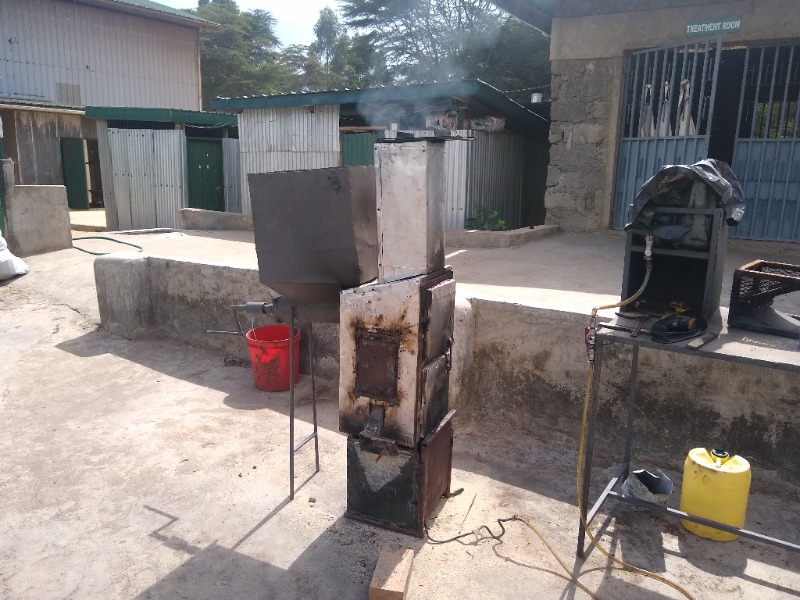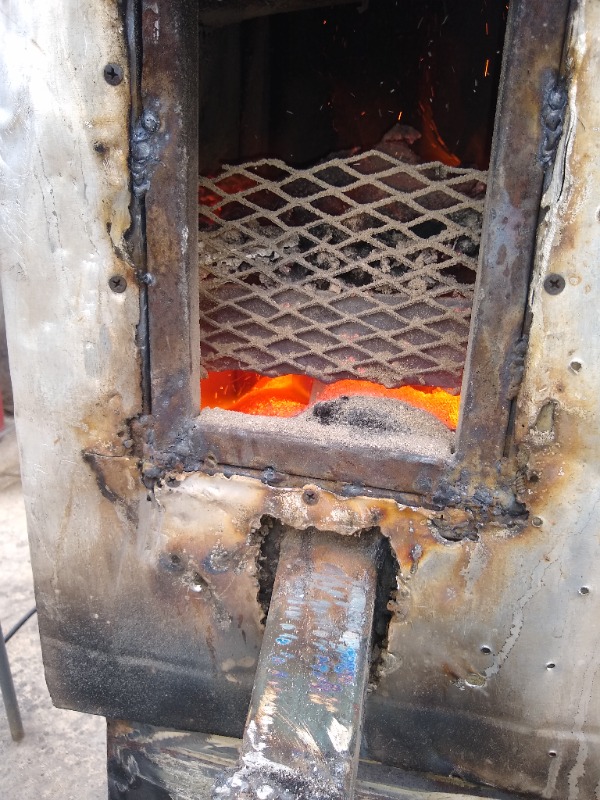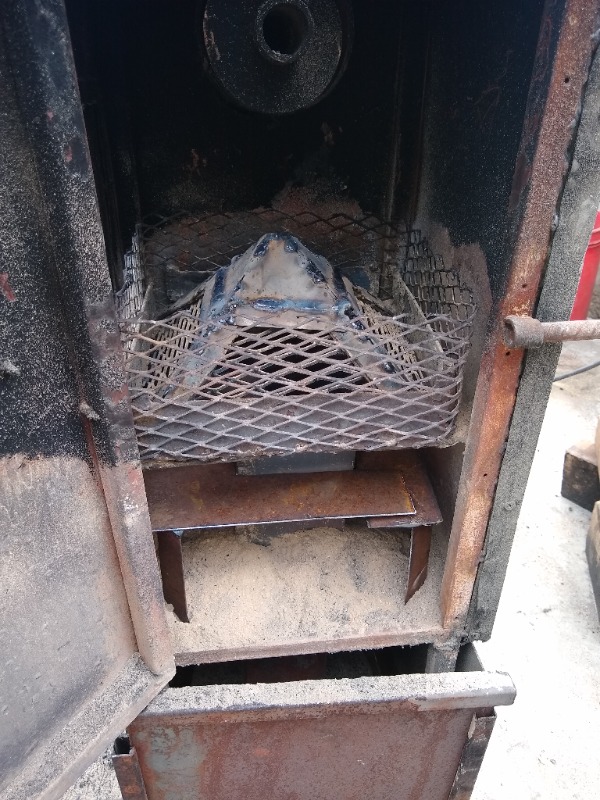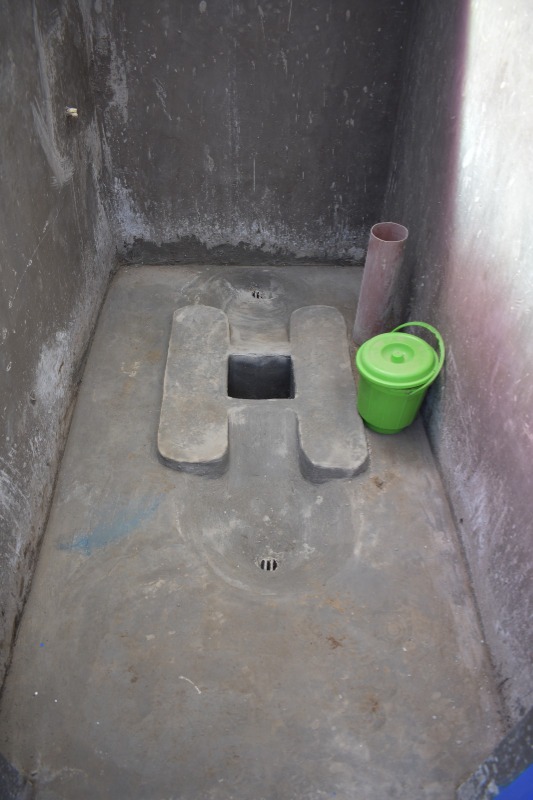- Sanitation systems
- Faecal sludge management (FSM)
- Faecal sludge treatment technologies
- Incineration of UDDT waste at healthcare facilities - request for feedback
Incineration of UDDT waste at healthcare facilities - request for feedback
15.3k views
Re: Incineration of UDDT waste at healthcare facilities - request for feedback
Sludge Incinerators typically operate at temperatures above 900C and are co-fired with fossil fuels. Human feces can be treated between 300C and 600C and has enough energy to dry and treat itself. UDDT waste often contains paper, sanitary products and plastic. This provides even more energy to safely treat the feces while preserving nutrients, destroying micro plastics such as PFAS, PFOS and pharmaceuticals. There is good published work to support. We also work in cold climates where biologic solutions such as AD and composting for small communities are not viable for safe treatment and vector attraction.
Jeff Hallowell
Biomass Controls PBC
Biomass Controls PBC
Please Log in to join the conversation.
You need to login to replyRe: Incineration of UDDT waste at healthcare facilities - request for feedback
This marks a step forward for UDDT applications. Certainly a good application for onsite disposal. As a manufacturer of UDDT's in Australia for Industry and individual uses, the disposal question is often raised and as yet no method that satisfies all situations has emerged. Incineration ( without effluent or reduced effluent) was raised with me some years ago when a user reported pathogen free results from micro waving the solids for short exposures . I would be interested in any views on this especially if there is some documentation of methods etc.
Cheers Ross
Cheers Ross
Please Log in to join the conversation.
You need to login to reply- tgurksi
-
 Less
Less- Posts: 14
- Karma: 2
- Likes received: 6
Re: Incineration of UDDT waste at healthcare facilities - request for feedback
An update on the incinerator testing:
We've gone through some iterations of designs and configurations, and overall, we have a well functioning prototype. There are some opportunities for improvement, but I thought I'd share some findings.
The incinerator is able to convert about 20kgs of poop/charcoal dust to ash in about 2.5 hours. This mass of waste is about what we are expecting for a week of toilet operation at a small hospital. It takes a while to cool down after the fuel input is turned off because the charcoal and poop are still burning. Over the 2.5 hours, it consumes about 4L of kerosene.
The poop is about 50% of the total waste, with the balance being charcoal dust. Based on calculations and observation, the dry material plays a huge role in the energy content of the waste. Since the poop is about 75% water, it means the dry fuel for burning is largely the charcoal dust. So, using non-combustible dry material (like ash) would have dramatically different performance. I would think sawdust would also burn just as well as charcoal dust. The moisture in the poop requires about the same amount of energy to burn off as the poop provides, so if the added dry material has a solid energy content, the energy balance works in your favor. External energy (kerosene in this case) is still needed to get the process going and sustained.
We don't have temperature data from inside the incinerator because of difficulty procuring a proper thermocouple probe and reader. Using an infrared temperature gun, we measure the outside of a metal door to get an idea of the temperature, but it's not reliable.
The kerosene stove works pretty well and is able to get the incinerator quite hot in only 10-15 minutes. The incinerator really gets hot once the charcoal and poop catch, which takes around 30 more minutes. We tried using used motor oil, but it burned inconsistently and had a lot more residue. The poop/charcoal burns similar to how a charcoal grill would burn because it's mostly charcoal. The volume of the waste is reduced by about 90% when converted to ash.
Regarding smoke and odor, the amount of smoke seems to mostly rely on the kerosene stove, not the poop. If it's burning low and efficiently, there's minimal smoke. At a high stove burn rate, there's more smoke. The odor from the incinerator is minimal overall. It is the highest if the waste is added to the incinerator at relatively low temperatures, but at moderate to higher temperatures, it isn't offensive. It doesn't smell like poop as most people know it to smell. If any of you have cooked poop in a pot to boiling, the odor is similar, but not strong. If we add a 2-3 meter emission stack, I don't think odor would be a problem even at a sensitive location like a healthcare facility.
After seeing it operate, we definitely have some ideas for improvements to make it simpler and cheaper, but this seems to show that incineration of poop from a UDDT toilet with combustible dry material is quite possible using a very simple system.
I realize it's not the most elegantly sustainable treatment and disposal solution, but for locations constrained by pathogens concerns, safety, and public perception, it could be useful to enable container-based style toilets.
Tore, the liquids (including anal-washing fluid) are disposed into a soak pit. Some toilets may have access to a septic system, which may be a preferred solution.
Eli
We've gone through some iterations of designs and configurations, and overall, we have a well functioning prototype. There are some opportunities for improvement, but I thought I'd share some findings.
The incinerator is able to convert about 20kgs of poop/charcoal dust to ash in about 2.5 hours. This mass of waste is about what we are expecting for a week of toilet operation at a small hospital. It takes a while to cool down after the fuel input is turned off because the charcoal and poop are still burning. Over the 2.5 hours, it consumes about 4L of kerosene.
The poop is about 50% of the total waste, with the balance being charcoal dust. Based on calculations and observation, the dry material plays a huge role in the energy content of the waste. Since the poop is about 75% water, it means the dry fuel for burning is largely the charcoal dust. So, using non-combustible dry material (like ash) would have dramatically different performance. I would think sawdust would also burn just as well as charcoal dust. The moisture in the poop requires about the same amount of energy to burn off as the poop provides, so if the added dry material has a solid energy content, the energy balance works in your favor. External energy (kerosene in this case) is still needed to get the process going and sustained.
We don't have temperature data from inside the incinerator because of difficulty procuring a proper thermocouple probe and reader. Using an infrared temperature gun, we measure the outside of a metal door to get an idea of the temperature, but it's not reliable.
The kerosene stove works pretty well and is able to get the incinerator quite hot in only 10-15 minutes. The incinerator really gets hot once the charcoal and poop catch, which takes around 30 more minutes. We tried using used motor oil, but it burned inconsistently and had a lot more residue. The poop/charcoal burns similar to how a charcoal grill would burn because it's mostly charcoal. The volume of the waste is reduced by about 90% when converted to ash.
Regarding smoke and odor, the amount of smoke seems to mostly rely on the kerosene stove, not the poop. If it's burning low and efficiently, there's minimal smoke. At a high stove burn rate, there's more smoke. The odor from the incinerator is minimal overall. It is the highest if the waste is added to the incinerator at relatively low temperatures, but at moderate to higher temperatures, it isn't offensive. It doesn't smell like poop as most people know it to smell. If any of you have cooked poop in a pot to boiling, the odor is similar, but not strong. If we add a 2-3 meter emission stack, I don't think odor would be a problem even at a sensitive location like a healthcare facility.
After seeing it operate, we definitely have some ideas for improvements to make it simpler and cheaper, but this seems to show that incineration of poop from a UDDT toilet with combustible dry material is quite possible using a very simple system.
I realize it's not the most elegantly sustainable treatment and disposal solution, but for locations constrained by pathogens concerns, safety, and public perception, it could be useful to enable container-based style toilets.
Tore, the liquids (including anal-washing fluid) are disposed into a soak pit. Some toilets may have access to a septic system, which may be a preferred solution.
Eli
Mechanical engineer and WASH implementer
Attachments:
Please Log in to join the conversation.
You need to login to reply- Tore
-
- worked in sanitation for most of my life. taught plumbing. have plumbing and builders license, certified inspector in all facets of construction, PhD in public administration & have taught construction management in university, traveled numerous countries, Interest UDDT and sanitation & clean water
Less- Posts: 75
- Karma: 2
- Likes received: 27
Re: Incineration of UDDT waste at healthcare facilities - request for feedback
You haveto remember that wet feces take a huge amount of energy to dry and subsequently burn. If you can store the feces for a period of time in an enclosure where there is a glass window to the south it would heat the inside and help dry the feces. Allowing some air to enter and installing a vent pipe to allow the water vapor to leave would help. The dryer the feces the less energy to burn.
Are you trying to use the urine for fertilizer or where does it go?
Tore
Are you trying to use the urine for fertilizer or where does it go?
Tore
Sanitation & water consultant in developing countries
Please Log in to join the conversation.
You need to login to replyRe: Incineration of UDDT waste at healthcare facilities - request for feedback
Thanks for the excellent feedback Chris and Jeff.
The UDDT toilets are concrete, manufactured onsite. A closer photo of a freshly constructed interface is below. The toilets are cleaned and containers are emptied every day in the morning before patients arrive. There is also a dedicated staff member onsite for user education and hygiene promotion, as well as data collection. There are also posters inside the toilet to remind users about adding dry material, liquids separation, and to put garbage in the chute, not the poop hole. So far, we've gotten some very nice data showing people like the toilets, largely because they are cleaned regularly and don't smell.
Regarding the trenches, it's a great and simple idea. Could be a great reason to reforest a hospital! I agree that we are finding incineration to be expensive, harder than you'd think, and it's unfortunate to not take advantage of the energy/nutrient value of poop. We are looking into incineration given the small quantity of poop and the cost of coordinating transport and reuse. Being poop from hospitals, there are some extra concerns about diseases too, so moving untreated poop offsite is a hurdle. Even burying untreated poop under a tree would need to be carefully considered to show it's safe.
Thanks for the numbers Jeff, that's great to see. We'll keep biochar in mind. There could be some benefits to having a reuse product if we can find someone to take it and pyrolysis seems a bit easier and less energy-intensive than incineration.
Eil
The UDDT toilets are concrete, manufactured onsite. A closer photo of a freshly constructed interface is below. The toilets are cleaned and containers are emptied every day in the morning before patients arrive. There is also a dedicated staff member onsite for user education and hygiene promotion, as well as data collection. There are also posters inside the toilet to remind users about adding dry material, liquids separation, and to put garbage in the chute, not the poop hole. So far, we've gotten some very nice data showing people like the toilets, largely because they are cleaned regularly and don't smell.
Regarding the trenches, it's a great and simple idea. Could be a great reason to reforest a hospital! I agree that we are finding incineration to be expensive, harder than you'd think, and it's unfortunate to not take advantage of the energy/nutrient value of poop. We are looking into incineration given the small quantity of poop and the cost of coordinating transport and reuse. Being poop from hospitals, there are some extra concerns about diseases too, so moving untreated poop offsite is a hurdle. Even burying untreated poop under a tree would need to be carefully considered to show it's safe.
Thanks for the numbers Jeff, that's great to see. We'll keep biochar in mind. There could be some benefits to having a reuse product if we can find someone to take it and pyrolysis seems a bit easier and less energy-intensive than incineration.
Eil
Mechanical engineer and WASH implementer
Attachments:
The following user(s) like this post: HarryTams
Please Log in to join the conversation.
You need to login to replyRe: Incineration of UDDT waste at healthcare facilities - request for feedback
Dear Eli,
It has been our experience from testing, that feces will volatilize between 483.3 °C and 500.6 °C. Our system feeds continuous between 9 and 33 kg per hour. Feces does have enough energy to dry and pyrolyze. In fact the energy balance is quite good for feces and very good from UDDTs since it dries a bit. Typical end of torrefaction and beginning of pyrolysis is 300C and ends around 900 C. Carbonization for feces is the best way to preserve nutrients and does not cause a hazardous waste such as ash. A TLUD is a simple system that can be used. Also rotary systems can work well. We have also found that the processing of menstrual waste is easy and begins to volatilize around 374C. Making biochar from organic feedstock is easy and best to make healthy soil. Our systems are continuous and priced about $0.01 per person per day from 10 people - 30,000 people but many batch and kiln systems are very inexpensive and simple to make and operate.
There are many videos on TLUDS and other style kilns. Here are a few links:
.
Dr Paul Anderson is a great resource and always willing to advise.
Kind regards,
Jeff
It has been our experience from testing, that feces will volatilize between 483.3 °C and 500.6 °C. Our system feeds continuous between 9 and 33 kg per hour. Feces does have enough energy to dry and pyrolyze. In fact the energy balance is quite good for feces and very good from UDDTs since it dries a bit. Typical end of torrefaction and beginning of pyrolysis is 300C and ends around 900 C. Carbonization for feces is the best way to preserve nutrients and does not cause a hazardous waste such as ash. A TLUD is a simple system that can be used. Also rotary systems can work well. We have also found that the processing of menstrual waste is easy and begins to volatilize around 374C. Making biochar from organic feedstock is easy and best to make healthy soil. Our systems are continuous and priced about $0.01 per person per day from 10 people - 30,000 people but many batch and kiln systems are very inexpensive and simple to make and operate.
There are many videos on TLUDS and other style kilns. Here are a few links:
.
Dr Paul Anderson is a great resource and always willing to advise.
Kind regards,
Jeff
Jeff Hallowell
Biomass Controls PBC
Biomass Controls PBC
The following user(s) like this post: HarryTams
Please Log in to join the conversation.
You need to login to replyRe: Incineration of UDDT waste at healthcare facilities - request for feedback
Dear Eli,
I think that incineration of wet poop will always be complicated, expensive, and ecologically unsustainable.
I would recommend burying these feces in the bottoms of deep holes where trees will be planted. If no local people want to plant trees (or if a whole row of trees is to be planted, for example as a windbreak), the feces could be buried in trenches, possibly 1.5 m deep (staying well above the water table), and covered with about 50 cm of the excavated soil, thus there would be no problem continuing with normal farming on top of the filled trenches. For this, the bins that collect the feces under the toilet could be lined with dry banana leaves (or green ones from plants that have been harvested), which also go into the hole or trench, thus facilitating the cleaning of these bins or possibly eliminating the need to wash them at all. A vertical board could be placed in the trench to keep the material in the part of the trench that is being filled ... and then be moved gradually along the whole length of the trench. This can be done at a prudent distance from rivers or wells for drinking water.
This would:
www.susana.org/en/knowledge-hub/resource...library/details/1679
I would also like to congratulate those who built and manage this unit on an especially tidy and presentable UDDT. Was the squat pan made in a factory or built on-site? Is the use explained personally to each new user or is an instruction sheet enough? Can you please post a photo looking straight down upon it?
Best wishes,
Chris Canaday
I think that incineration of wet poop will always be complicated, expensive, and ecologically unsustainable.
I would recommend burying these feces in the bottoms of deep holes where trees will be planted. If no local people want to plant trees (or if a whole row of trees is to be planted, for example as a windbreak), the feces could be buried in trenches, possibly 1.5 m deep (staying well above the water table), and covered with about 50 cm of the excavated soil, thus there would be no problem continuing with normal farming on top of the filled trenches. For this, the bins that collect the feces under the toilet could be lined with dry banana leaves (or green ones from plants that have been harvested), which also go into the hole or trench, thus facilitating the cleaning of these bins or possibly eliminating the need to wash them at all. A vertical board could be placed in the trench to keep the material in the part of the trench that is being filled ... and then be moved gradually along the whole length of the trench. This can be done at a prudent distance from rivers or wells for drinking water.
This would:
- encapsulate the material in the soil, eliminating any contact with it and essentially any risk of disease transmission;
- improve local soils, contributing to better agriculture and food security;
- generate work for local non-skilled laborers would do the digging;
- sequester carbon into the soil, contributing to the mitigation of Global Climate Disruption.
www.susana.org/en/knowledge-hub/resource...library/details/1679
I would also like to congratulate those who built and manage this unit on an especially tidy and presentable UDDT. Was the squat pan made in a factory or built on-site? Is the use explained personally to each new user or is an instruction sheet enough? Can you please post a photo looking straight down upon it?
Best wishes,
Chris Canaday
Conservation Biologist and EcoSan Promoter
Omaere Ethnobotanical Park
Puyo, Pastaza, Ecuador, South America
inodoroseco.blogspot.com
Omaere Ethnobotanical Park
Puyo, Pastaza, Ecuador, South America
inodoroseco.blogspot.com
The following user(s) like this post: Heiner
Please Log in to join the conversation.
You need to login to reply- tgurksi
-
 Less
Less- Posts: 14
- Karma: 2
- Likes received: 6
Re: Incineration of UDDT waste at healthcare facilities - request for feedback
Thanks Chaiwe and Tom,
Here's a quick update on where this research stands at the moment.
To our knowledge, container-based sanitation (CBS) hasn't been tested and evaluated at healthcare facilities. I suppose bedpans are a form of CBS, but they are normally quickly transferred to a toilet immediately. Incineration of medical waste is somewhat common, but not for poop. Healthcare facilities likely wouldn't even consider incineration of poop if they rely on pit latrines or septic systems.
The reason we are looking at onsite treatment is because the treatment plant we've been sending waste to isn't close to some other facilities we would also like to evaluate. Transportation of the waste is a significant cost of managing CBS, so if we can do it all onsite, it improves the overall financial viability. It also allows us to keep everything in one location which is easier to manage. Regarding cost of treatment, we are looking to take the principles of higher tech incinerators and make an appropriate design - nothing electric, just simple welded or ceramic designs - otherwise it probably wouldn't be viable. Our thought is that an effective CBS system, coupled with a reliable incinerator could provide a long-term, sanitary, and cost-effective solution, but the incinerator component is the missing piece at the moment.
It's possible that incinerating poop in its wetter form is too energy intensive to be viable. Using external energy is ok, within reason. We are in the early stages of testing this. We've found poop burns at around 400C surface temperature and burns well in a furnace of at least 725C, which is very hot. Cooler than that and it smoulders, which is slow and emits some odors. Breaking up the poop so it dries and has good contact with hot air is essential for faster burning.
Thanks for your thoughts. I'll keep updating as we find out more.
Eli
Here's a quick update on where this research stands at the moment.
To our knowledge, container-based sanitation (CBS) hasn't been tested and evaluated at healthcare facilities. I suppose bedpans are a form of CBS, but they are normally quickly transferred to a toilet immediately. Incineration of medical waste is somewhat common, but not for poop. Healthcare facilities likely wouldn't even consider incineration of poop if they rely on pit latrines or septic systems.
The reason we are looking at onsite treatment is because the treatment plant we've been sending waste to isn't close to some other facilities we would also like to evaluate. Transportation of the waste is a significant cost of managing CBS, so if we can do it all onsite, it improves the overall financial viability. It also allows us to keep everything in one location which is easier to manage. Regarding cost of treatment, we are looking to take the principles of higher tech incinerators and make an appropriate design - nothing electric, just simple welded or ceramic designs - otherwise it probably wouldn't be viable. Our thought is that an effective CBS system, coupled with a reliable incinerator could provide a long-term, sanitary, and cost-effective solution, but the incinerator component is the missing piece at the moment.
It's possible that incinerating poop in its wetter form is too energy intensive to be viable. Using external energy is ok, within reason. We are in the early stages of testing this. We've found poop burns at around 400C surface temperature and burns well in a furnace of at least 725C, which is very hot. Cooler than that and it smoulders, which is slow and emits some odors. Breaking up the poop so it dries and has good contact with hot air is essential for faster burning.
Thanks for your thoughts. I'll keep updating as we find out more.
Eli
Mechanical engineer and WASH implementer
The following user(s) like this post: HarryTams
Please Log in to join the conversation.
You need to login to reply- Chaiwe
-

- Moderator
- Innovation enthusiast and Knowledge Management Expert in WASH and Climate Change while cross-cutting Youth and Gender Issues. CEO of CaDev_Capacity Development (An African Social Enterprise)
Less- Posts: 336
- Karma: 8
- Likes received: 116
Re: Incineration of UDDT waste at healthcare facilities - request for feedback
Hi Eli,
This could be quite an interesting topic for research. I have done some looking around for information on small onsite incinerators and possible ways of drying wet poop without drying it under the sun, but i haven't come across relevant examples where it has worked successfully.
Could it be that health facilities find incineration of UDDT waste onsite costly as mentioned, especially in the African region? Have you by any chance in evaluating container-based sanitation at health facilities come across some reasons why onsite incineration for UDDT waste is not considered by most health facilities?
Does onsite incineration offer more relevant benefits than offsite incineration/ treatment and disposal?
If it does could you kindly share some relevant examples that you have come across since you posted this topic?
Regards,
Chaiwe.
This could be quite an interesting topic for research. I have done some looking around for information on small onsite incinerators and possible ways of drying wet poop without drying it under the sun, but i haven't come across relevant examples where it has worked successfully.
Could it be that health facilities find incineration of UDDT waste onsite costly as mentioned, especially in the African region? Have you by any chance in evaluating container-based sanitation at health facilities come across some reasons why onsite incineration for UDDT waste is not considered by most health facilities?
Does onsite incineration offer more relevant benefits than offsite incineration/ treatment and disposal?
If it does could you kindly share some relevant examples that you have come across since you posted this topic?
Regards,
Chaiwe.
SuSanA Forum Moderator
Skat Foundation (With financial support by GIZ and SIRWASH up to November 2023)
Chaiwe Mushauko-Sanderse BSc. NRM, MPH
Independent consultant located in Lusaka, Zambia
Emails: This email address is being protected from spambots. You need JavaScript enabled to view it., This email address is being protected from spambots. You need JavaScript enabled to view it.
LinkedIn: www.linkedin.com/in/chaiwe-mushauko-sanderse-21709129/
Twitter: @ChaiweSanderse
Skat Foundation (With financial support by GIZ and SIRWASH up to November 2023)
Chaiwe Mushauko-Sanderse BSc. NRM, MPH
Independent consultant located in Lusaka, Zambia
Emails: This email address is being protected from spambots. You need JavaScript enabled to view it., This email address is being protected from spambots. You need JavaScript enabled to view it.
LinkedIn: www.linkedin.com/in/chaiwe-mushauko-sanderse-21709129/
Twitter: @ChaiweSanderse
Please Log in to join the conversation.
You need to login to reply- tgurksi
-
 Less
Less- Posts: 14
- Karma: 2
- Likes received: 6
Re: Incineration of UDDT waste at healthcare facilities - request for feedback
Hi Eli,
All of the systems that I'm aware of are either complex, or require external energy. To burn feces without external energy requires high efficiency and a means of drying the feces using the heat of combustion, which generally leads to complexity and cost. To burn it simply, external energy is typically utilized, which can be in the form of an external fuel that is burned, or dry material that is mixed with the feces. If the cost and supply chain of an external energy source is not prohibitive, this is probably the better choice for your application. At that point, the actual incinerator doesn't need to be anything particularly special, and there is probably a commercially available unit that would do the job.
Cheers,
Tom
All of the systems that I'm aware of are either complex, or require external energy. To burn feces without external energy requires high efficiency and a means of drying the feces using the heat of combustion, which generally leads to complexity and cost. To burn it simply, external energy is typically utilized, which can be in the form of an external fuel that is burned, or dry material that is mixed with the feces. If the cost and supply chain of an external energy source is not prohibitive, this is probably the better choice for your application. At that point, the actual incinerator doesn't need to be anything particularly special, and there is probably a commercially available unit that would do the job.
Cheers,
Tom
The following user(s) like this post: JillHass
Please Log in to join the conversation.
You need to login to reply
Share this thread:
- Sanitation systems
- Faecal sludge management (FSM)
- Faecal sludge treatment technologies
- Incineration of UDDT waste at healthcare facilities - request for feedback
Recently active users. Who else has been active?
Time to create page: 0.451 seconds












